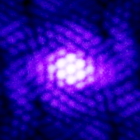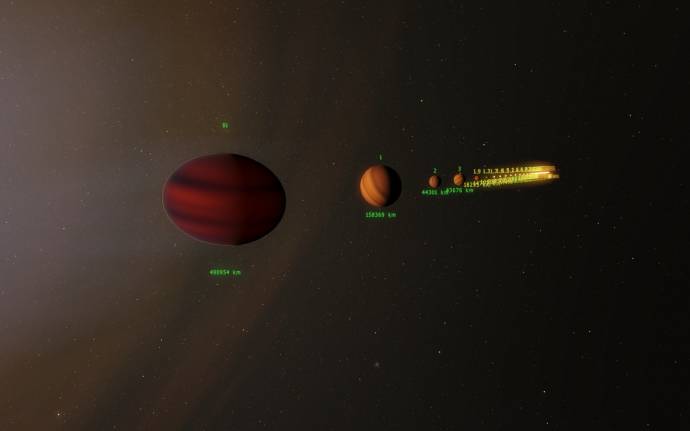|
Space anomalies
|
|
| apenpaap | Date: Thursday, 08.01.2015, 10:12 | Message # 316 |
 World Builder
Group: Users
 Antarctica
Antarctica
Messages: 1063
Status: Offline
| Quote NickWaterfall (  ) I wonder if there are octuple systems..
Not sure if it's still true in this version, but from what I recall there were indeed octuple ones in 0.95, but that was the limit. No nonuple ones.
Incidentally, the Castor system is a sextuple one, so we can actually easily see one of them in real life.
I occasionally stream at http://www.twitch.tv/magistermystax. Sometimes SE, sometimes other games.
|
| |
| |
| Unnamed | Date: Thursday, 08.01.2015, 19:27 | Message # 317 |
|
Space Pilot
Group: Users
 Mexico
Mexico
Messages: 116
Status: Offline
| I was messing around and..
i found an asteroid dwarf moon in a collision orbit into a larger moon in the system and then i started speeding up time until they were almost colliding
Some days after that i found a warm ice world
And its moon, a hot desert that reminds me of hubble´s picture of pluto
Intel® Core™ i5-3210M CPU @ 2.50GHz 2.50 GHz 750 GB hard drive 4 GB RAM intel ®HD Graphics 4000 1GB video; oh and i use a lot of commas
Edited by Unnamed - Thursday, 08.01.2015, 19:28 |
| |
| |
| Watsisname | Date: Thursday, 08.01.2015, 19:33 | Message # 318 |
 Galaxy Architect
Group: Global Moderators
 United States
United States
Messages: 2613
Status: Offline
| It would be interesting to run a large number of n-body simulations of collapsing molecular clouds / star forming regions, and plot the histogram for the number of stars formed in all stable systems that result. I am guessing it would follow some inverse power law, so each extra member becomes exceedingly more rare. Also, at some point, it stops behaving like a star system, and more like a globular cluster or a galaxy.
Another interesting note is that, if taken very seriously, then the n-body stability logic I employed earlier would suggest that globulars and galaxies are not stable. So obviously the logic isn't perfect, right?
Actually, no, the logic works and these are not dynamically stable objects! It's just that the instability isn't obvious except on very large timescales. Star systems are all orbiting the galaxy rather haphazardly, with nothing preventing collisions or near misses except the vast distances between them relative to their size. But every so often systems do pass close to one another, flinging some members inward and others outward. So the long term behavior is that globular clusters and galaxies "evaporate", with stars flung into intergalactic space or feeding the central black hole. This process takes so long though that by the time it makes a significant difference, star formation has ceased and most stars have become cold remnants. Collisions between whole galaxies is also more important in the current era of the universe.

|
| |
| |
| Aerospacefag | Date: Thursday, 08.01.2015, 20:17 | Message # 319 |
 Pioneer
Group: Users
 Russian Federation
Russian Federation
Messages: 401
Status: Offline
| Quote Unnamed (  ) Some days after that i found a warm ice world
Apparently it is the exactly the type of world we get there. It is ice world because program calculates the type of the world according to it's position in the system, before applying additional effects. It is warm because it is very close to it's satellite very close and tidal forces are heating the interior of the plaent.
|
| |
| |
| MalzM | Date: Thursday, 08.01.2015, 23:23 | Message # 320 |
 Observer
Group: Newbies
 Germany
Germany
Messages: 8
Status: Offline
| Mh... I tried to find systems with >7 stars for a while now, and till now I did not manage to find one (except a 14 star one, but it had a black hole of course). For some reason the search is likely to crash in some galaxies, even if the star density there is similar to one where the search works just fine... It's really hard to get more then 70k lightyears as radius on my machine without having it crashing : /
|
| |
| |
| Watsisname | Date: Friday, 09.01.2015, 04:10 | Message # 321 |
 Galaxy Architect
Group: Global Moderators
 United States
United States
Messages: 2613
Status: Offline
| Wow, 70k search radius is a LOT. Very often that is a larger diameter than the whole galaxy! I usually search no more than 1k, and more often just 100. 

|
| |
| |
| MalzM | Date: Friday, 09.01.2015, 12:39 | Message # 322 |
 Observer
Group: Newbies
 Germany
Germany
Messages: 8
Status: Offline
| yeah, I stayed in that range for a long time, that's why I always thought 5 star solars system would be rare :P
But as I said, it's really hard to get higher, in some galaxies I can't even get past 30k. I wonder what is limiting the search, it can't be the memory...
Edited by MalzM - Friday, 09.01.2015, 12:49 |
| |
| |
| Aerospacefag | Date: Friday, 09.01.2015, 15:08 | Message # 323 |
 Pioneer
Group: Users
 Russian Federation
Russian Federation
Messages: 401
Status: Offline
| MalzM, the search of stars is limited not only by range but in the most times by 10000 limit of displayed stars. 30-50 ly radius is usually giving this amount, everything above that quantity is being excluded.
|
| |
| |
| KSpanier | Date: Friday, 09.01.2015, 15:26 | Message # 324 |
|
Observer
Group: Users
 Germany
Germany
Messages: 16
Status: Offline
| I found a system with two inhabitated planets, but both went through biogenesis

Edited by KSpanier - Friday, 09.01.2015, 15:26 |
| |
| |
| spacer | Date: Friday, 09.01.2015, 21:55 | Message # 325 |
 Star Engineer
Group: Users
 Israel
Israel
Messages: 1258
Status: Offline
| KSpanier, and? life can be abiogenesis even in 5 planets in the same system, the life started on the planets. are you sure that you didnt found 2 panspermia and no abiogenesis in the system? if so its can be anomalies, i still didnt found system with panspermia life without abiogenesis life in the system. and its need to be out there, maybe life went from system to system? but its rare?
"we began as wanderers, and we are wanderers still"
-carl sagan
-space engine photographer
|
| |
| |
| NickWaterfall | Date: Friday, 09.01.2015, 22:29 | Message # 326 |
|
Space Tourist
Group: Users
 Norway
Norway
Messages: 23
Status: Offline
| Good lord... a scorched ice giant with a diameter of almost half a million kilometers.
RS 0-2-54-1253-499-1-7-631 B1
490954.406km
EDIT: Apparently whenever the ridiculous ice giant is in my view, my computer starts to heat up and struggle..
Edited by NickWaterfall - Friday, 09.01.2015, 22:33 |
| |
| |
| Ingolifs | Date: Friday, 09.01.2015, 22:39 | Message # 327 |
|
Space Tourist
Group: Users
 New Zealand
New Zealand
Messages: 30
Status: Offline
| Quote NickWaterfall (  ) Good lord... a scorched ice giant with a diameter of almost half a million kilometers.
RS 0-2-54-1253-499-1-7-631 B1
490954.406km

Wow, good find. That's probably the most oblate planet I've seen. It also has only 8 earth masses, giving it a surface gravity of almost nothing.
It's in such an unlikely orbit as well - around that blue giant orbiting the red giant.
The planet next to it on the pic is slightly larger than Jupiter.
|
| |
| |
| MalzM | Date: Saturday, 10.01.2015, 00:51 | Message # 328 |
 Observer
Group: Newbies
 Germany
Germany
Messages: 8
Status: Offline
| Aerospacefag, looks like you are right somehow, I always believed it would only display 10000 in the list at one time, and kick the one at the end out... I really don't get the current implementation of the search, because when it's about calculation time the system seems to work through the whole defined radius... So I really don't get why it just randomly discards everything above 10k. I don't see how this is necessary.
|
| |
| |
| Portalmell | Date: Saturday, 10.01.2015, 03:13 | Message # 329 |
 Observer
Group: Users
 Australia
Australia
Messages: 16
Status: Offline
| This shouldn't exist...

RS 8401-0-4-3789-993 1
  
|
| |
| |
| Ingolifs | Date: Saturday, 10.01.2015, 07:46 | Message # 330 |
|
Space Tourist
Group: Users
 New Zealand
New Zealand
Messages: 30
Status: Offline
| Why are these hot jupiters always so oblate? Since they're tidally locked, their rotation period should be the same as their orbital period, and nowhere near fast enough to cause such a deviation from spherical. Are there other mechanisms at play that create such oblateness?
|
| |
| |